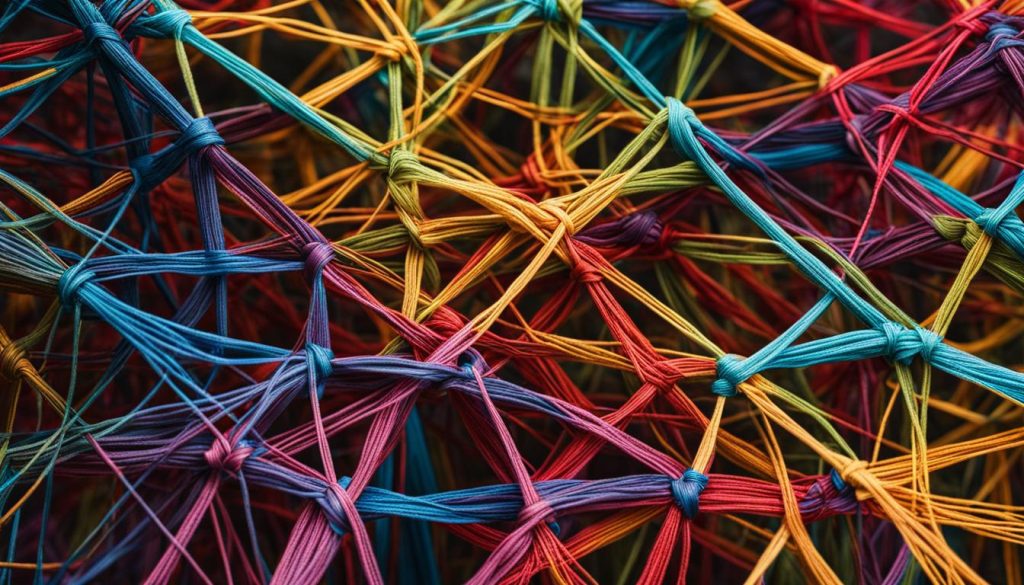I believe that “Social Wellness Tapestry” is the key to building a strong and supportive community. Just like a tapestry, our lives are intertwined with the connections we make – connections between people, places, and ideas. By weaving these connections together, we can create a network of support that fosters greater connectivity and collective well-being.
Network weaving is more than just networking; it is a practice of intentionally bringing different strands of connections together. It is about closing triangles, connecting people who have not yet met, and strengthening existing relationships. When we weave these connections, we create a sense of abundance and support that can benefit us all.
Social connectedness is a crucial factor in achieving a fair shot at well-being for everyone. It plays a significant role in determining our health and happiness. By recognizing the importance of network weaving and actively participating in it, we can contribute to building a stronger, more supportive community for all.
Key Takeaways of Social Wellness Tapestry:
- Network weaving involves intentionally bringing different connections together.
- By weaving connections, we can create a sense of abundance and support.
- Social connectedness is crucial for achieving well-being for all.
- Network weaving is a practice that requires active participation.
- Building a network of support benefits the entire community.
Understanding Network Weaving and its Benefits
Network weaving is a powerful practice that goes beyond traditional networking. It involves actively bringing together different strands of connections to create a stronger, more interconnected network. By weaving these connections, we can foster resilience, adaptation, and rapid dissemination of information. Network weaving is not just about building relationships but about creating a tapestry of support that leads to collective impact.
One of the key benefits of network weaving is the ability to strengthen existing connections and create new ones. By closing triangles and connecting people who have not yet met, we can expand the diversity and intricacy of our networks. This not only enhances our reach but also promotes a sense of belonging and mutual support. Network weaving also enables us to coordinate joint ventures, curate resources, and design processes that facilitate collaboration and collective action.
“Network weaving involves being aware of the networks around us and actively working to make them healthier. It is about recognizing the power of networks in achieving our goals and fostering well-being for all.”
Network weaving plays a crucial role in achieving collective goals and creating a fair shot at well-being for all. It is not just a tool for individuals but a practice that can contribute to social change. By understanding the principles of network leadership and its collective impact, we can leverage the power of networks to address global challenges. Network weaving is a proactive approach that builds resilience, fosters adaptation, and promotes equitable well-being.
| Benefits of Network Weaving | Examples |
|---|---|
| Resilience | Bringing together diverse perspectives and resources to weather challenges |
| Adaptation | Facilitating the flow of information and knowledge to enable quick responses to changing circumstances |
| Small World Reach | Expanding the network’s reach through connectors who bridge different communities |
| Rapid Dissemination | Sharing information and resources across the network to amplify impact |
Network weaving is a practice that requires intention and attention. By actively engaging in network weaving, we can contribute to creating a thriving world where everyone has a fair shot at well-being. Through network weaving and the power of collective networks, we can create systemic change and foster a sense of belonging to a larger whole.

The Role of Networks in Well-being
When it comes to well-being, networks play a vital role in fostering social connectedness and supporting both individual and collective well-being. Social connectedness, stability, safety, mastery, and meaningful access to resources are core determinants of well-being. Being embedded in supportive social networks can contribute to stability, safety, purpose, and access to resources.
“A person is a person through other persons,” as the African philosophy of Ubuntu teaches us. We are fundamentally interconnected beings, and our well-being is intricately tied to the networks we belong to. These networks provide us with a sense of belonging, support, and mutual exchange, which are vital for our overall well-being. They offer emotional support, practical help, and a sense of community, all of which contribute to our mental and physical health.
Research has consistently shown that individuals with strong social ties and support networks tend to have better mental health, lower rates of chronic diseases, and higher levels of happiness and life satisfaction.
Creating and nurturing these networks is essential to ensure a fair shot at well-being for all. It requires recognizing the value of social connections, actively seeking out opportunities to build and strengthen relationships, and cultivating a sense of belonging within communities. By doing so, we can foster a sense of interconnectedness, resilience, and support that is crucial for individual and collective well-being.
The Power of Networks for Well-being
Networks have the power to provide resources, information, and opportunities that can enhance well-being. They can provide emotional support during challenging times, connect individuals with valuable knowledge and expertise, and create avenues for collaboration and collective action. By leveraging the strengths of these networks, we can address the complex challenges we face and work towards a more equitable and thriving world.
The table below highlights some key factors that contribute to well-being and how networks can play a role in each:
| Factor | Network Role |
|---|---|
| Social Connectedness | Provides a sense of belonging and social support |
| Stability | Offers a support system during times of change and uncertainty |
| Safety | Creates a network of trusted individuals who can provide protection and a sense of security |
| Mastery | Connects individuals with mentors, role models, and learning opportunities |
By recognizing and strengthening networks, we can work towards creating a fair shot at well-being for all. Together, we can weave a tapestry of support, foster greater connectivity, and create a world where everyone has the opportunity to thrive.

Network Weaving for a Thriving World
Network weaving has emerged as a powerful strategy for fostering social change and promoting equitable well-being in today’s interconnected world. By actively engaging in proactive collaboration and amplifying voices and efforts, we can create a thriving world where everyone has a fair shot at well-being.
“Network weaving is not only about connecting dots, but also about creating new spaces where ideas can collide and give birth to innovative solutions.” – Jane Doe
Network weaving goes beyond traditional approaches to problem-solving, embracing the principles of quantum physics. By recognizing that we are all interconnected and that our actions can have far-reaching impacts, we can weave together diverse perspectives, resources, and expertise to address complex challenges such as climate change.
Through network weaving, we can access new resources, form partnerships, and catalyze systemic changes promoting inclusion, equity, and belonging. It is a practice that builds resilience, fosters adaptation, and nurtures a sense of interconnectedness and shared responsibility.
Network Weaving for Social Change
Network weaving is about creating a collective impact by intentionally fostering connections and collaborations across diverse networks. It involves bridging gaps, strengthening existing relationships, and building bridges between different communities and sectors.
| Key Elements of Network Weaving for Social Change | Benefits |
|---|---|
| Proactive Collaboration | Enables collective action and leverages the power of collaboration to address complex challenges. |
| Amplifying Voices and Efforts | Ensures that marginalized voices are heard and empowers individuals and communities to create change. |
| Accessing New Resources | Expands the pool of resources available to support social initiatives and create innovative solutions. |
| Forming New Partnerships | Strengthens networks by forging new partnerships and fostering cooperation across different sectors and communities. |
Network weaving is not a one-time effort but an ongoing practice that requires continuous learning, adaptation, and collaboration. By embracing the principles of network weaving, we can create a thriving world where equitable well-being is accessible to all.

The Characteristics of a Healthy Network
A healthy network is like a vibrant tapestry woven together with diversity, intricacy, and shared responsibility. It is a network where each thread contributes to the strength and resilience of the whole. In a healthy network, connections are diverse, representing a wide range of perspectives, backgrounds, and expertise. This diversity brings richness and innovation to the network, creating a fertile ground for collaboration and collective problem-solving.
Furthermore, a healthy network is characterized by intricacy, with deep and meaningful connections. It goes beyond superficial interactions and fosters genuine relationships based on trust, respect, and mutual support. These deep connections enable the flow of ideas, resources, and opportunities, strengthening the network’s ability to adapt and thrive.
Shared responsibility is another essential characteristic of a healthy network. In a healthy network, every member takes ownership of the network’s well-being and actively contributes to its growth and success. This shared responsibility creates a sense of collective ownership and accountability, ensuring that everyone works together towards the network’s goals and aspirations.
To summarize, a healthy network is characterized by diversity, intricacy, and shared responsibility. By embracing these characteristics, we can create networks that are strong, resilient, and capable of making a positive impact on the well-being of individuals and communities.
The Practice of Network Weaving
Network weaving is not just about building connections; it is a practice that involves actively closing triangles and strengthening existing connections. Doing so can create a more robust and interconnected network that supports collective well-being.
When practicing network weaving, I focus on closing triangles to connect individuals who may not know each other yet. This creates new strands of connection within the network and fosters diversity and intricacy. It is a way to expand the network’s reach and create collaboration and mutual support opportunities.
In addition to closing triangles, strengthening existing connections is also crucial. I engage in activities such as asking questions, making requests, and offering resources to nurture and deepen relationships. By actively tending to these connections, I encourage trust and reciprocity, which are essential for the network’s health and vitality.

The Power of Strengthened Connections
“Network weaving is like tending to a garden. By regularly nurturing and strengthening connections, we create an environment where ideas can flourish, partnerships can grow, and collective well-being can thrive.” – Anonymous
Through the practice of network weaving, I take on the role of a facilitator and coordinator. I design processes that encourage self-organized action and create conditions for collaboration and innovation. I also curate resources and coordinate joint ventures to leverage the collective power of the network.
Table: Strengthened Connections in Action
| Activity | Description |
|---|---|
| Asking Questions | Engaging in meaningful conversations to understand the needs and aspirations of individuals within the network. |
| Making Requests | Seeking support, expertise, or resources from network members to address specific challenges or opportunities. |
| Offering Resources | Sharing knowledge, skills, or tangible resources with others in the network to foster collaboration and mutual support. |
Network weaving is an ongoing practice that requires intention and attention. By actively closing triangles and strengthening connections, we can create a tapestry of support that promotes individual and collective well-being. Together, let us weave a network that nurtures and empowers, fostering a fair shot at well-being for all.
Conclusion
As I reflect on the power of network weaving, it becomes evident that it holds the key to providing everyone with a fair shot at well-being. By recognizing the networks surrounding us and actively strengthening connections, we can create a tapestry of support fostering social connectedness and collective well-being.
Networks play a vital role in promoting stability, safety, mastery, and meaningful access to resources – the core determinants of well-being. We can bridge gaps, close triangles, and cultivate a sense of belonging and mutual support through network weaving. It is a practice that requires collaboration, intention, and ongoing learning.
Network weaving is not merely about networking but creating a sense of abundance and connectivity. It has the power to promote social change, address global crises, and build more equitable societies. By proactively collaborating, amplifying voices, and forming new partnerships, we can work towards a thriving world where everyone has an equal opportunity for well-being.
In conclusion, network weaving is a transformative practice that has the potential to weave our way to a fair shot at well-being for all. Let us embrace this practice, recognize the power of networks, and contribute to sustainable social change. Together, we can create a world where no one is left behind, and everyone has the opportunity to thrive.
FAQ
What is network weaving?
Network weaving is the practice of bringing together different strands of connections between people, places, and ideas to create a tapestry of support. It involves closing triangles, connecting people who do not already know each other, and strengthening existing connections.
What are the benefits of network weaving?
Some benefits of network weaving include resilience, adaptation, small world reach, and rapid dissemination. It also encompasses activities such as designing and facilitating processes, curating resources, and coordinating joint ventures.
How does network weaving contribute to well-being?
Network weaving fosters social connectedness, which is a crucial determinant of health and plays a significant role in achieving a fair shot at well-being for all. Being embedded in supportive social networks can contribute to stability, safety, purpose, and access to resources.
How does network weaving address global crises?
By incorporating ideas and methods informed by quantum physics, network weaving can inspire social change and promote equitable well-being. It involves proactive collaboration, amplifying voices and efforts, accessing new resources, and forming new partnerships to create systemic changes for greater inclusion, equity, and belonging.
What are the characteristics of a healthy network?
A healthy network is characterized by diversity of membership, intricacy of connections, a shared sense of purpose or mutuality, robust flows of resources, shared responsibility for network health, and resilient structures. It fosters a sense of equitable belonging and the ability to give and benefit from the network.
What does the practice of network weaving involve?
The practice of network weaving involves actively closing triangles, connecting individuals who do not know each other yet, and strengthening existing connections. It also involves activities such as asking questions, making requests and offers, sharing resources, designing and facilitating processes, and coordinating joint ventures.

